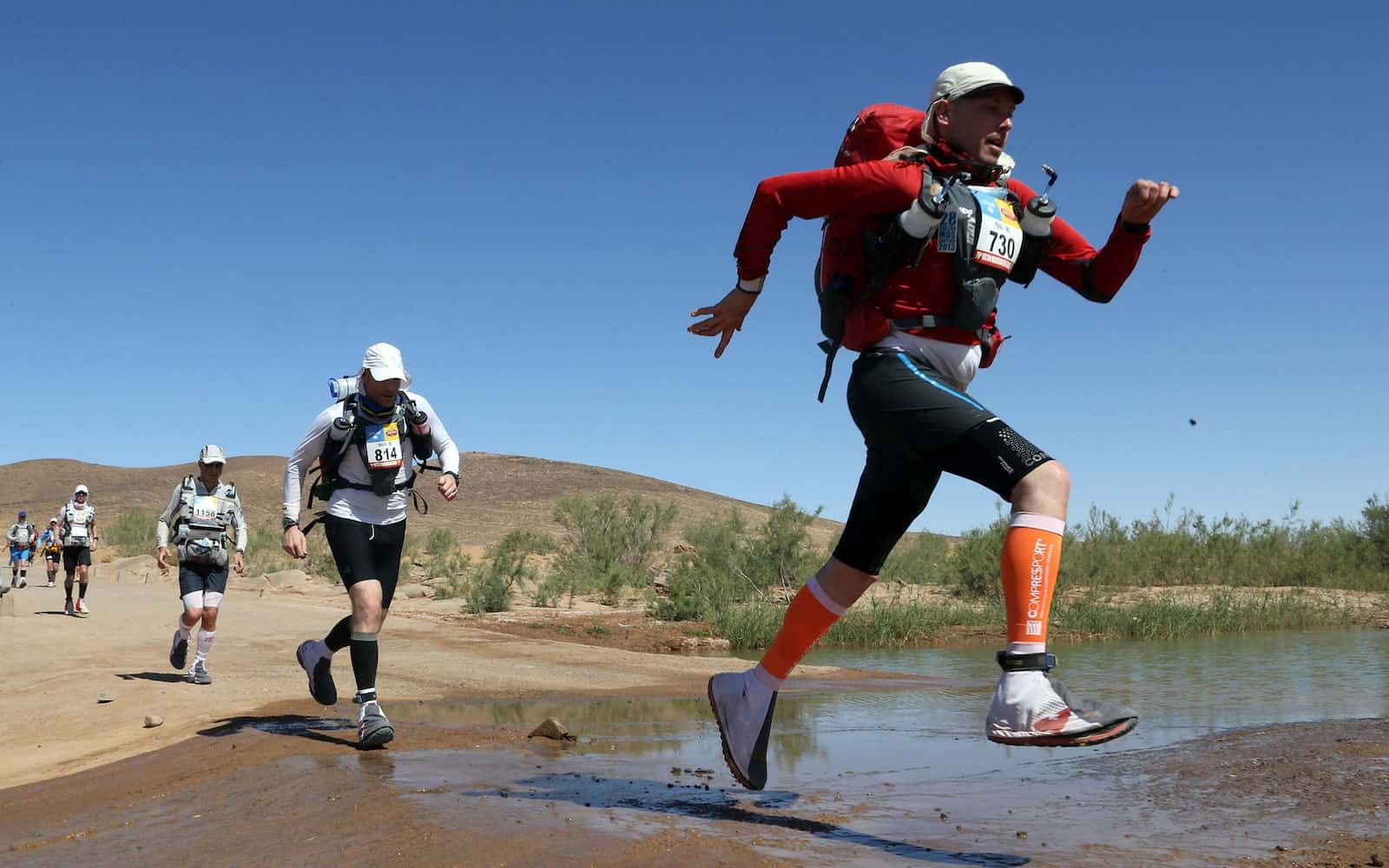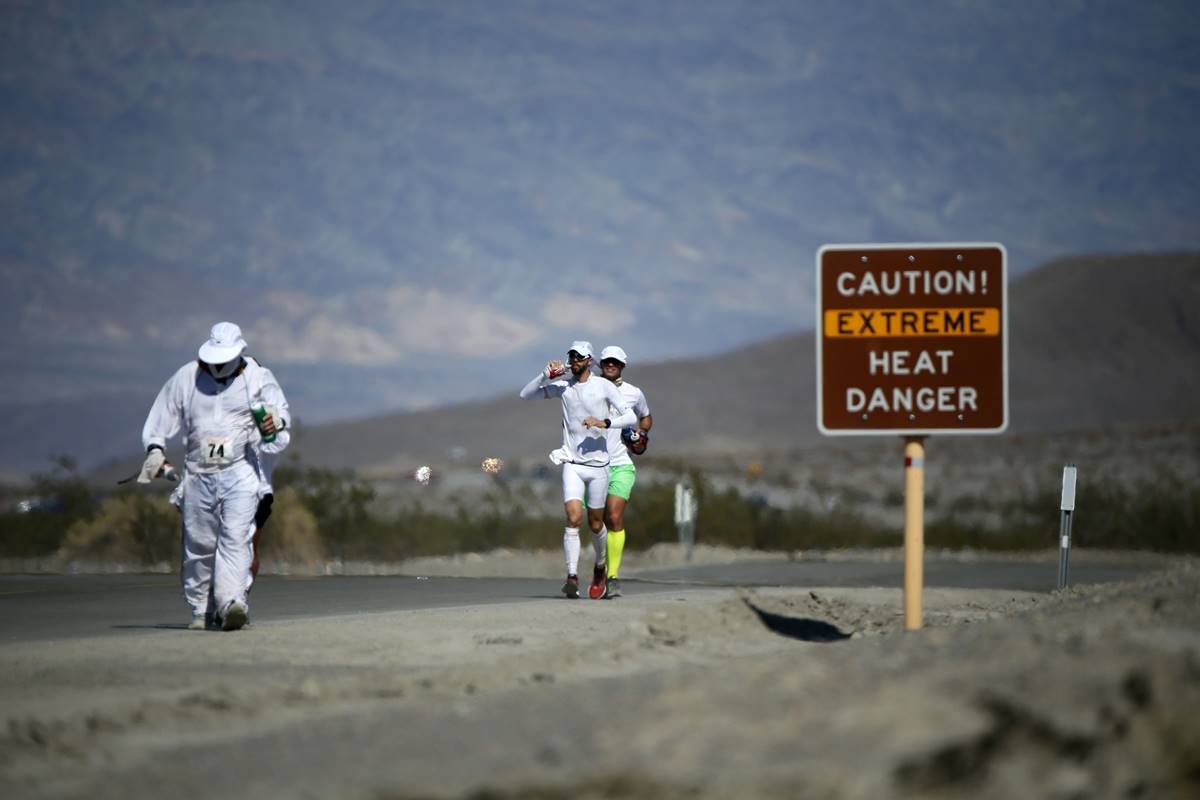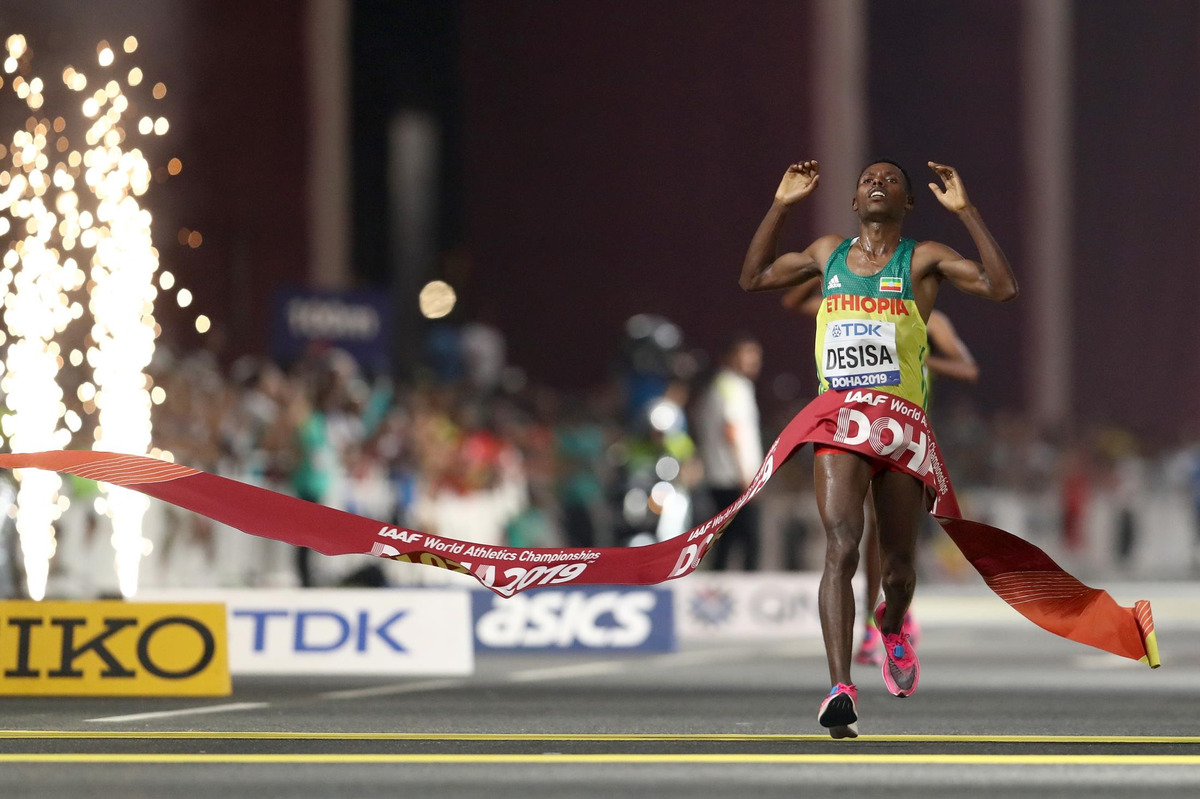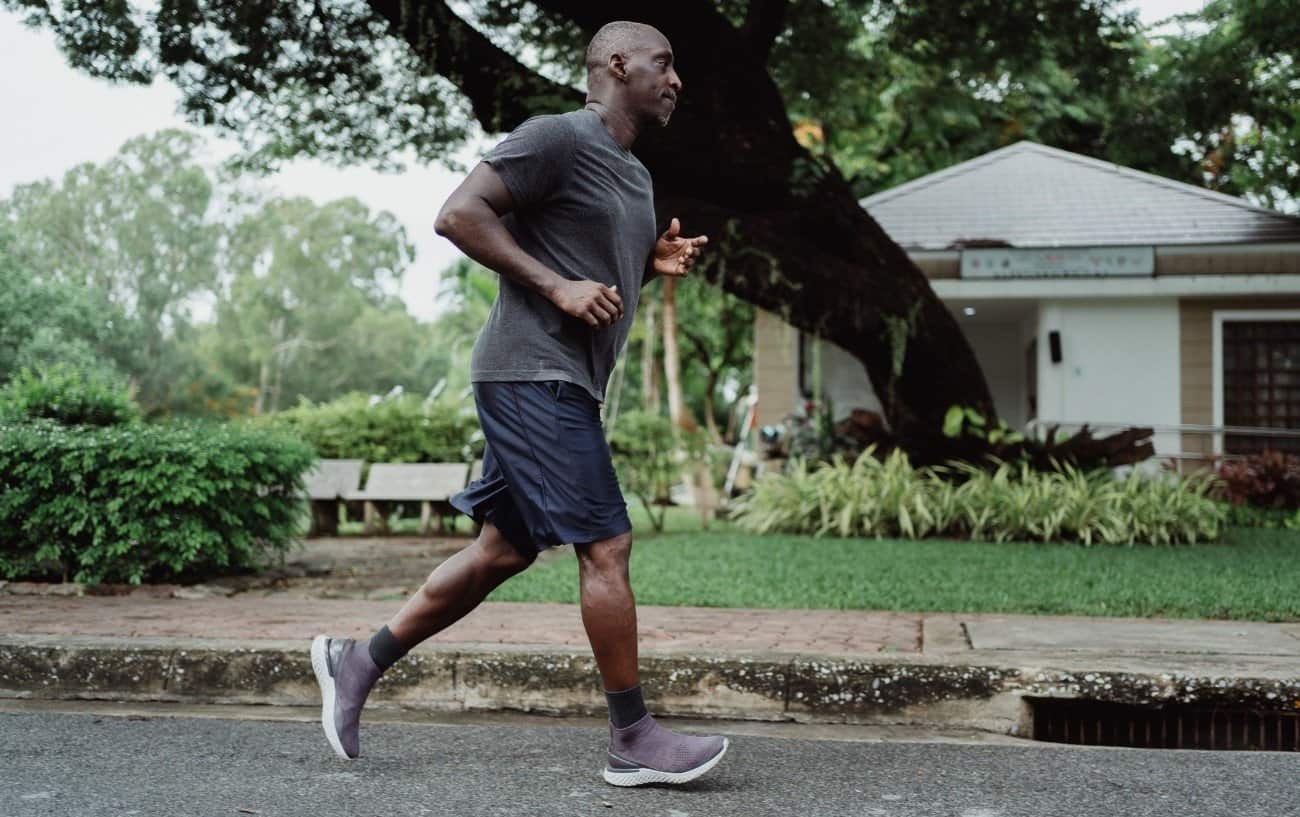

Featured
Who Is The Greatest Ultramarathon Runner
Modified: January 22, 2024
Discover the remarkable achievements of the featured ultramarathon runner, who is considered as one of the greatest in the sport. Uncover their inspiring journey and record-breaking performances.
Introduction
Ultramarathon running is not for the faint of heart. It is a sport that pushes the boundaries of human endurance, challenging individuals to run distances that extend far beyond the traditional marathon length of 26.2 miles. In recent years, ultramarathon running has gained significant popularity, attracting athletes from all walks of life who are drawn to the physical and mental challenge it presents.
Defined as any race distance that exceeds the marathon length, ultramarathons can range from 50 kilometers to several hundred miles. These races take place in diverse terrains, from mountains and deserts to jungles and icy tundras. The relentless pursuit of the finish line requires not only physical strength but also mental fortitude, as runners must navigate through fatigue, pain, and self-doubt.
The origins of ultramarathon running can be traced back to ancient times. The legendary Pheidippides, an ancient Greek messenger, is said to have run approximately 26 miles from the battlefield of Marathon to Athens to deliver news of victory. This heroic feat inspired the modern marathon, and eventually, the idea of running longer distances began to capture the imagination of endurance athletes.
While ultramarathon running has been around for centuries, it wasn’t until the 1970s and 1980s that it gained recognition as an organized sport. The Western States Endurance Run, first held in 1974, is often credited as one of the first official ultramarathons. Since then, the sport has grown rapidly, with an increasing number of races held worldwide and a dedicated community of ultrarunners who push the boundaries of what is possible.
Ultramarathon running is not solely about winning races; it is a personal journey of self-discovery and resilience. The sport attracts individuals who are driven by the desire to challenge themselves physically and mentally, to push beyond their limits, and to prove that the human body is capable of extraordinary feats.
In this article, we will delve into the world of ultramarathon running, exploring the historical perspectives, notable runners, performance factors, psychological aspects, physical demands and training, nutrition, injury prevention, and the future of the sport. Join us as we unravel the secrets behind the endurance, passion, and determination of the greatest ultramarathon runners in the world.
Defining Ultramarathon Running
Ultramarathon running is a form of long-distance running that goes beyond the traditional marathon distance of 26.2 miles. As the name suggests, an ultramarathon is any race that exceeds this standard marathon distance, pushing runners to test their limits and explore the boundaries of human endurance.
Ultramarathons come in various formats, each with its own unique challenges. Some popular ultramarathon distances include 50 kilometers (31 miles), 100 kilometers (62 miles), 50 miles, 100 miles, and even multi-day races that cover several hundred miles. These races are often held on diverse terrains, such as trails, mountains, deserts, or even through urban environments.
What sets ultramarathon running apart from traditional marathons is the duration and mental fortitude required to complete the race. While a marathon typically takes less than six hours to finish for elite runners, ultramarathons can take anywhere from several hours to several days. Runners need to be prepared to endure physical and mental challenges, pacing themselves effectively and maintaining a strong mindset throughout the race.
Ultramarathon races can be undertaken as solo endeavors or as part of a team, with each format presenting its own set of unique dynamics. Some runners choose to participate in self-supported races, carrying their own food, water, and equipment, while others compete in races with aid stations along the course to provide support and supplies.
It is worth noting that ultramarathon running is not only limited to organized races. Some runners take on personal challenges, aiming to complete a set distance or conquer a specific route. These solo efforts, often referred to as “ultra-adventures,” showcase the individual’s courage, determination, and self-reliance.
In recent years, ultramarathon running has experienced a surge in popularity, attracting athletes from various backgrounds. The allure of testing one’s physical and mental limits, exploring breathtaking landscapes, and connecting with a vibrant community of like-minded individuals has made ultramarathon running an appealing choice for many.
Ultimately, ultramarathon running is all about pushing the boundaries of what is perceived as possible. It is a sport that challenges individuals to dig deep, confront their fears, and discover the resilience and inner strength they never knew they had. Whether it is conquering a specific distance, completing a grueling trail race, or embarking on a personal adventure, ultramarathon running offers a unique blend of physical and emotional challenges that continue to captivate runners around the world.
Historical Perspectives
Ultramarathon running has a rich history that dates back to ancient times. While the modern sport has evolved significantly, its roots can be traced back to the endurance feats of early civilizations.
One of the first recorded instances of long-distance running can be found in Greek mythology. The story of Pheidippides, a Greek messenger, who ran approximately 26 miles from the battlefield of Marathon to Athens in 490 BCE to deliver news of victory, laid the foundation for the modern marathon. This heroic display of endurance and determination inspired the creation of the marathon race, which has become synonymous with the Olympic Games.
As time went on, the human desire to test the limits of endurance led to the emergence of ultramarathon-like events in different parts of the world. One notable event was the pilgrimage of the Japanese Buddhist monk Shugendo Yamabushi, who would embark on long-distance journeys through treacherous terrains in search of spiritual enlightenment. These arduous treks, known as Kaihogyo, involved walking more than 1,000 kilometers over a period of 100 days.
In the 19th century, ultramarathons gained recognition in Europe. The Paris-Brest-Paris bicycle race, established in 1891, covered a challenging distance of 1,200 kilometers. Around the same time, the annual 24-hour pedestrian races held in the United States gained popularity. These races tested participants’ endurance as they competed to see who could cover the greatest distance within a 24-hour period.
Ultramarathon running as we know it today began to take shape in the mid-20th century. The idea of running longer distances than the traditional marathon started to gain traction, and the fascination with pushing human limits grew. The Comrades Marathon, an iconic ultramarathon held in South Africa since 1921, played a pivotal role in popularizing ultramarathon running on a global scale. The race covers a challenging 90-kilometer course and attracts participants from around the world.
In the 1970s and 1980s, the sport experienced a surge in popularity, with the establishment of organized ultramarathon races. One significant event was the Western States Endurance Run, first held in 1974. This 100-mile race through the Sierra Nevada Mountains in California has become one of the most prestigious ultramarathons in the world, attracting elite runners as well as dedicated amateurs.
Since then, ultramarathon races of varying distances and terrains have proliferated worldwide. From the iconic Ultra-Trail du Mont-Blanc, which circumnavigates Europe’s highest peak, to the grueling Badwater Ultramarathon in Death Valley, California, which involves running 135 miles in extreme desert conditions, there is no shortage of epic races that test the limits of human endurance.
The historical perspectives of ultramarathon running reveal a deep-rooted fascination with pushing the boundaries of what is physically and mentally possible. From ancient myths to modern-day races, the quest for personal achievement, self-discovery, and the exploration of the human spirit continue to drive ultramarathon runners to push beyond the limits of traditional running events.
Notable Ultramarathon Runners
Ultramarathon running has produced a remarkable group of athletes who have distinguished themselves through their extraordinary achievements. These individuals have pushed the boundaries of human endurance, setting records, and inspiring others with their perseverance, determination, and unwavering spirit.
One iconic figure in the world of ultramarathon running is Kilian Jornet. Hailing from Catalonia, Spain, Jornet is widely regarded as one of the greatest endurance athletes of our time. He has dominated the world of mountain ultramarathons, consistently breaking records and pushing the limits of what is possible. Jornet’s accomplishments include setting speed records on some of the world’s most challenging peaks, such as Mount Kilimanjaro and Mount Everest.
Another notable ultramarathon runner is Scott Jurek, an American athlete known for his incredible feats in the sport. Jurek’s impressive career includes numerous victories in ultramarathon races, including a record-breaking seven consecutive wins in the Western States Endurance Run. He is also renowned for his plant-based diet and commitment to environmental sustainability, inspiring others to adopt healthier and more conscientious lifestyles.
Pam Reed, an American ultramarathon runner, has made a significant impact on the sport with her remarkable achievements. Reed became the first woman to win the overall title in the Badwater Ultramarathon, a race notorious for its extreme conditions and grueling terrain. Her mental toughness and ability to endure physical challenges have solidified her place as one of the most remarkable ultrarunners in history.
Dean Karnazes, often referred to as the “Ultramarathon Man,” is a true legend in the sport. Karnazes gained widespread recognition through his extraordinary long-distance running abilities and his ability to endure extreme conditions. He has completed multiple ultramarathons, including running 50 marathons in 50 consecutive days in all 50 states of the United States. Karnazes is also known for his advocacy of active lifestyles and inspiring individuals to step outside their comfort zones.
Among the notable ultramarathon runners is Ann Trason, an American athlete who has left an indelible mark on the sport. Trason dominated the women’s ultramarathon scene in the 1980s and 1990s, consistently setting records and winning races. Her incredible performances include multiple victories in the Western States Endurance Run and setting the women’s 100-mile world record, which stood unbroken for over 14 years.
These are just a few examples of the remarkable individuals who have made their mark on the world of ultramarathon running. Their incredible achievements have inspired countless others to pursue their own endurance goals and transcend the boundaries of what is considered possible.
Through their dedication, resilience, and unwavering determination, these notable ultramarathon runners have proven that the human body and spirit are capable of extraordinary feats. They serve as a source of inspiration for both seasoned ultrarunners and those considering embarking on their own endurance journey.
Comparing Ultramarathon Achievements
Comparing ultramarathon achievements is a challenging task, as there are numerous factors to consider. The distances, terrains, and conditions of races can vary significantly, making direct comparisons difficult. However, certain metrics can be used to provide insights into the extraordinary accomplishments of ultramarathon runners.
One common metric used to compare ultramarathon achievements is the distance covered within a specific time frame. For example, the total distance covered in a 24-hour race can highlight the runner’s endurance and pace. Some of the most impressive performances in this category have seen runners exceed 160 miles (257 km) within a single day.
Another significant achievement to consider is the speed at which a runner completes a specific distance. For instance, the fastest known time (FKT), often associated with specific trails or routes, showcases the runner’s speed and efficiency. Runners strive to break existing records on well-known routes such as the Appalachian Trail or the Pacific Crest Trail.
Course records in popular ultramarathon races are another way to assess competitors’ achievements. These records provide a benchmark for current and future participants and reflect the fastest times achieved on a particular course.
The level of competition within a race is also an important factor to consider when comparing achievements. Races that attract a highly competitive field, with elite athletes from around the world, are generally considered more prestigious. Winning or placing highly in a race with strong competition demonstrates an athlete’s ability to perform under pressure and against top-tier opponents.
The ability to consistently perform at a high level in multiple races is another noteworthy accomplishment. Runners who demonstrate consistent success across various distances and terrains showcase their versatility and adaptability as ultramarathon athletes.
It is important to recognize that each individual’s ultramarathon achievement is unique and should be appreciated within their own context. Factors such as personal goals, overcoming adversity, and the mental and emotional journey experienced by each runner should not be overlooked when comparing achievements.
In summary, comparing ultramarathon achievements requires careful consideration of various factors, including distance covered, speed, course records, level of competition, and consistency. However, it is crucial to remember that each runner’s journey is unique, and their achievements are a testament to their dedication, perseverance, and the challenges they have overcome along the way.
Analyzing Performance Factors
When it comes to ultramarathon running, several factors contribute to an athlete’s performance and ability to excel in this demanding sport. Understanding and analyzing these performance factors can provide valuable insights into what separates the top ultramarathon runners from the rest of the field.
One crucial performance factor is physical fitness. Ultramarathon runners must possess a high level of aerobic endurance and muscular strength. Endurance training, including long runs, speed workouts, and hill repeats, helps build the cardiovascular and muscular stamina required to endure the prolonged exertion of ultramarathons. Strength and conditioning exercises, particularly for the core and lower body, enhance running efficiency and minimize the risk of fatigue-related injuries.
Mental resilience is another critical performance factor. Ultramarathons are as mentally challenging as they are physically demanding. Runners must possess mental fortitude to overcome fatigue, pain, and self-doubt during the race. Mental training techniques, such as visualization, positive affirmations, and developing strategies for coping with the inevitable lows, can help athletes maintain focus and motivation throughout the race.
Strategic race planning and pacing are essential performance factors in ultramarathons. Runners must gauge their effort and energy expenditure to ensure they have enough reserves to complete the race. Balancing speed and sustainable pacing is crucial, especially in races that span several hours or days. Effective race planning also involves considering the terrain, weather conditions, aid station locations, and nutrition and hydration strategies.
Nutrition and hydration play significant roles in the performance of ultramarathon runners. Endurance events require careful fueling to maintain energy levels and prevent issues such as dehydration and bonking. Runners must develop a nutrition plan that suits their individual needs and preferences, ensuring they consume an appropriate balance of carbohydrates, proteins, and fats during the race. Hydration is equally vital, with runners needing to replenish fluids regularly, often with the assistance of aid stations or self-carried hydration systems.
Proper recovery and injury prevention are crucial for sustaining performance in ultramarathons. Runners must prioritize adequate rest, sleep, and active recovery practices to allow the body to repair and adapt. Incorporating strength and flexibility exercises, regular massage or foam rolling, and proper post-race nutrition can aid in the prevention of common ultramarathon-related injuries and enhance overall performance.
Environmental factors, such as weather conditions and terrain, also impact performance in ultramarathons. Adapting to challenging and unpredictable conditions, such as extreme temperatures or altitudes, requires mental and physical resilience. Familiarizing oneself with the race course and terrain can help runners optimize their training and prepare for specific challenges they may encounter during the event.
Finally, the support network and community surrounding ultramarathon runners can significantly influence their performance. Having a team or fellow runners to train with, share experiences, and offer support can be invaluable. The encouragement and camaraderie of the ultrarunning community can provide motivation and inspiration, helping runners reach their full potential.
Analyzing these performance factors provides valuable insights into the multifaceted nature of ultramarathon running. From physical fitness and mental resilience to race planning, nutrition, recovery, and environmental adaptation, numerous elements come together to determine the success of an ultramarathon runner. Understanding and optimizing these factors can contribute to improved performance and a more fulfilling ultrarunning experience.
Psychological Aspects of Ultramarathon Running
Ultramarathon running is not just a physical challenge; it is a mental journey that pushes runners to explore the depths of their psychological resilience and strength. The psychological aspects of ultramarathon running play a significant role in determining an athlete’s success and ability to overcome the hurdles faced during the race.
Mental toughness is a key attribute for ultramarathon runners. The ability to persevere through challenging moments, overcome self-doubt, and maintain focus and determination in the face of fatigue is crucial. Developing mental toughness involves training the mind to stay positive, embrace discomfort, and embrace the unexpected challenges that may arise during the race.
Psychological preparation is essential in ultramarathon running. Visualizing success, setting realistic goals, and cultivating a positive mindset can help runners stay motivated and focused throughout the race. By mentally rehearsing race scenarios, anticipating potential obstacles, and developing strategies to cope with them, runners can build confidence in their ability to overcome challenges.
Motivation is a driving force in ultramarathon running. Understanding the underlying reasons why one engages in this demanding sport can provide a powerful source of motivation during training and the race itself. Whether it’s personal fulfillment, the desire to push boundaries, or the pursuit of a specific goal, finding intrinsic motivation can be a key factor in sustaining performance and enjoyment during ultramarathons.
Self-awareness and self-regulation are crucial psychological skills for ultramarathon runners. Being aware of one’s physical and mental state during the race allows runners to adjust their pace, hydration, and nutrition strategies accordingly. Self-regulation involves maintaining a balanced emotional state, managing stress, and adapting to changing circumstances to optimize performance.
Ultramarathon runners often experience a wide range of emotions during the race, including exhilaration, frustration, excitement, and despair. Learning to navigate these emotional highs and lows is essential. Developing emotional resilience, the ability to regulate emotions and maintain focus through challenges, can help runners stay in control and make rational decisions during difficult moments.
Support from the ultrarunning community and having a strong support network can also have a profound impact on the psychological well-being of runners. Encouragement, camaraderie, and shared experiences can provide a sense of belonging and motivation. The presence of friends, family, or fellow runners along the race course can offer vital emotional support and inspiration.
Mindfulness and the ability to stay present in the moment are valuable skills for ultramarathon runners. Focusing on the present helps runners cope with the physical demands and discomfort of long-distance running. By staying mindful, runners can embrace the challenges with a non-judgmental and accepting mindset, enhancing their overall experience.
The psychological aspects of ultramarathon running are multifaceted and deeply intertwined with an athlete’s overall performance and enjoyment. Developing mental toughness, harnessing motivation, practicing self-awareness, managing emotions, and finding support within the running community are essential in unlocking one’s true potential in the world of ultramarathon running.
Physical Demands and Training
Ultramarathon running presents significant physical demands that require specific training to prepare the body for the challenges it will face during the race. From the cardiovascular system to muscular endurance, adequate physical preparation is essential for success in this demanding sport.
One of the primary physical demands of ultramarathon running is cardiovascular endurance. Ultramarathons can be long and grueling, lasting several hours, days, or even longer. Building a strong aerobic base through consistent endurance training is crucial. This involves regular long runs, gradually increasing distance and time on feet, to improve cardiovascular fitness and the body’s ability to sustain a steady pace over an extended period.
Muscular endurance is another critical aspect of physical preparation for ultramarathon running. Endurance-specific strength training, with a focus on the lower body and core, helps runners build the muscular strength and stability needed to withstand the repetitive impact and extended duration of running. Incorporating exercises such as squats, lunges, planks, and single-leg exercises can improve muscular endurance, reduce the risk of injury, and enhance running efficiency.
Flexibility and mobility are often overlooked but play an essential role in preventing injuries and maintaining proper running form. Incorporating regular stretching, mobility exercises, and foam rolling can improve range of motion, joint stability, and overall movement mechanics.
Terrain-specific training is crucial for ultramarathons that take place on challenging terrains such as trails, mountains, or deserts. Incorporating elevation gains, technical trail running, and simulated race conditions in training allows runners to better adapt to the demands of the race course.
Mental endurance and training are as important as physical conditioning. Long runs can also serve as an opportunity to practice mental resilience, simulating the mental challenges that arise during ultramarathons. Gradually increasing training volume and intensity can help build both physical and mental toughness.
Planning and periodization are vital in ultramarathon training. Scheduling progressive training blocks with periods of increased volume and intensity, followed by recovery periods, allows the body to adapt and grow stronger while reducing the risk of overuse injuries and burnout. A well-designed training plan considers individual goals, race distance, and time available for training.
Nutrition and hydration strategies are also key components of physical preparation for ultramarathon running. Understanding the body’s nutritional needs during endurance events, practicing fueling during long training runs, and implementing hydration plans are essential for maintaining energy levels, preventing dehydration, and optimizing race performance.
Rest and recovery are just as crucial as training in ultramarathon preparation. Allowing the body time to rest and repair through adequate sleep, rest days, and active recovery practices is essential for preventing overtraining and optimizing performance.
Ultramarathon running places significant physical demands on the body, requiring specialized training to prepare for the rigors of the race. Building cardiovascular endurance, muscular strength and endurance, flexibility and mobility, and mental resilience are crucial aspects of physical preparation. By designing a well-rounded training plan that incorporates terrain-specific exercises, periodization, and proper nutrition and recovery strategies, runners can ensure they are physically prepared to take on the unique challenges of ultramarathon running.
Nutrition and Endurance
Nutrition plays a critical role in the performance and endurance of ultramarathon runners. Proper fueling and hydration strategies are essential for maintaining energy levels, preventing fatigue, and optimizing performance over the long distances and extended durations of an ultramarathon.
Carbohydrates are the primary source of fuel for endurance activities, making them a key component of an ultramarathon runner’s nutrition plan. Consuming a sufficient amount of carbohydrates before, during, and after a race or long training run helps replenish glycogen stores and provides an immediate source of energy. Complex carbohydrates, such as whole grains, fruits, and vegetables, are recommended for sustained energy release.
Protein is another important macronutrient for ultramarathon runners, as it aids in the repair and maintenance of muscle tissue. Consuming an adequate amount of protein through sources like lean meats, poultry, fish, beans, and legumes can support muscle recovery and prevent muscle breakdown during prolonged activity.
Fats are also necessary for ultramarathon running, as they provide a concentrated source of energy. Including healthy fats from sources like nuts, seeds, avocados, and fatty fish can help provide sustained energy during long-distance running. Additionally, fats play a role in supporting cellular function, hormone production, and vitamin absorption.
Hydration is vital for ultramarathon runners to maintain fluid balance and prevent dehydration. Fluid needs vary between individuals, weather conditions, and the duration of the race. Developing a hydration strategy that includes regular fluid intake and electrolyte replenishment is critical for optimal performance. Electrolyte-rich drinks or electrolyte tablets can help replace electrolytes lost through sweat.
In longer ultramarathons, runners may need to replenish calories and nutrients on the go. This often involves consuming energy gels, energy bars, or other easily digestible sources of carbohydrates during the race to maintain energy levels. It is important to practice race-day nutrition during training to determine what works best for individual needs and preferences.
Timing is essential when it comes to nutrition and endurance. Pre-race meals should be consumed 2-4 hours before the race, allowing enough time for digestion and avoiding discomfort during the start of the event. During the race, runners should aim to consume small frequent snacks or fluids to maintain a steady supply of energy.
However, nutrition is not one-size-fits-all. Each runner may have individual dietary needs and preferences. It is important to experiment during training to determine what foods and hydration techniques work best for oneself. Seek advice from a sports nutritionist or registered dietitian for personalized recommendations and guidance.
In summary, nutrition plays an integral role in the endurance and performance of ultramarathon runners. Adequate carbohydrate intake, protein for muscle repair, healthy fats for sustained energy, and proper hydration are key components of an ultramarathon nutrition plan. Developing a race-day nutrition strategy, practicing fueling during training, and considering individual dietary needs and preferences are essential for maintaining energy levels, preventing fatigue, and optimizing performance during ultramarathons.
Injury Prevention and Recovery
In ultramarathon running, injury prevention and effective recovery strategies are crucial for maintaining optimal performance and overall well-being. The physical demands of long-distance running, coupled with the repetitive nature of the sport, can place significant stress on the body. Here are some key considerations for injury prevention and recovery in ultramarathon running.
Proper training and gradual progression are fundamental for preventing injuries. Gradually increasing mileage, incorporating rest days, and allowing adequate recovery between intense training sessions are essential to minimize the risk of overuse injuries. Following a structured training plan that includes a mix of running surfaces and terrains can help reduce the impact on specific muscles and joints.
Strength training is an important aspect of injury prevention. Focusing on the muscles that support running, particularly the core, hips, glutes, and lower limbs, can help improve running efficiency, stability, and prevent imbalances. Exercises such as lunges, squats, planks, and resistance band work can strengthen these areas and reduce the risk of common running injuries.
Flexibility and mobility exercises should not be overlooked. Maintaining good range of motion in joints and muscles can improve running economy and reduce the risk of injuries. Incorporating dynamic warm-up exercises, regular stretching, and foam rolling can help enhance flexibility and prevent tightness or imbalances that can lead to injury.
Rest and recovery play a vital role in injury prevention. Allow the body time to rest and repair through adequate sleep and rest days. Active recovery practices such as stretching, foam rolling, or low-impact activities like swimming or cycling can promote blood circulation, reduce muscle soreness, and aid in recovery.
Nutrition and hydration are essential for both injury prevention and recovery. Consuming a balanced diet that includes adequate micronutrients, macronutrients, and hydration supports tissue repair, immune function, and overall health. Proper fueling before, during, and after workouts or races can replenish energy stores, support muscle recovery, and reduce the risk of injuries.
Monitoring and addressing any signs of discomfort or injury promptly is crucial. Ignoring warning signs can lead to more severe issues. If pain or discomfort persists, it is advisable to seek professional guidance from a healthcare provider experienced in sports medicine.
Cross-training, incorporating other low-impact activities or alternative forms of exercise, can help reduce the risk of overuse injuries and improve overall fitness. Swimming, cycling, or strength training can provide variety in training, work complementary muscle groups, and allow the body to recover from the repetitive impact of running.
Finally, adopting a mindset of patience and listening to one’s body is key. Pushing through pain or ignoring signs of injury can lead to more severe issues that could sideline a runner for an extended period. Prioritizing rest, recovery, and injury prevention in training and race preparation can help sustain long-term performance and enjoyment in ultramarathon running.
Injury prevention and effective recovery strategies are essential components of ultramarathon training and racing. Implementing a multifaceted approach that includes strength training, flexibility work, proper nutrition and hydration, rest and recovery, and seeking professional guidance when needed can help ultramarathon runners stay healthy, reduce the risk of injuries, and ensure they can continue to pursue their endurance goals for the long term.
The Future of Ultramarathon Running
The future of ultramarathon running holds endless possibilities as the sport continues to gain popularity and evolve. Here are some key trends and potential developments that may shape the future of this demanding and captivating endurance pursuit.
Technological advancements will play a significant role in the future of ultramarathon running. Wearable devices, such as GPS watches and fitness trackers, already provide runners with a wealth of data about their performance. In the future, we may see further innovations that enhance real-time tracking, biofeedback, and nutrition optimization. These technologies have the potential to improve training programs, enhance race-day strategies, and help runners maximize their potential.
Virtual reality (VR) and augmented reality (AR) technologies are also likely to impact the future of ultramarathon running. These immersive experiences could enable runners to explore race routes or train on virtual terrains, providing a realistic simulation of the challenges they may face. Additionally, AR enhancements during races could provide live route information, aid station locations, and real-time competitor updates, further enhancing the race experience.
Ultramarathon events may become more accessible and inclusive in the future. As interest in the sport grows, we may see a greater variety of race distances, terrains, and formats to cater to different skill levels and preferences. This could include shorter ultramarathon races, relay-style events, or multi-day stage races designed to accommodate a wider range of participants.
Environmental sustainability is likely to become a greater consideration in ultramarathon events. Race organizers may prioritize eco-friendly practices, such as minimizing waste, utilizing renewable energy sources, and implementing initiatives to reduce the carbon footprint of races. Such sustainability efforts align with the growing awareness and commitment to protecting the natural environments in which these races take place.
The global ultrarunning community will continue to expand, fostering connections and sharing experiences among runners across borders and cultures. Social media platforms and online communities provide a space for runners to connect, share advice, and inspire one another. As the sport grows, we may see organized international gatherings or global ultramarathon events that bring together the diverse and passionate ultrarunning community.
Scientific research on ultramarathon training, nutrition, and performance optimization is likely to advance in the future. As the sport gains more attention, ongoing studies may provide deeper insights into the physiological and psychological demands of ultramarathon running. This research can inform training methodologies, injury prevention strategies, and nutrition guidelines, further supporting runners in achieving their goals.
In summary, the future of ultramarathon running holds exciting prospects. Technological advancements, inclusivity, environmental sustainability, and the continued growth of the global ultrarunning community are just some of the factors that will shape the evolution of the sport. As runners embrace these advancements and push their own boundaries, the possibilities for remarkable achievements and new experiences in ultramarathon running are endless.
Conclusion
Ultramarathon running is a challenging and exhilarating sport that pushes the limits of human endurance. From the historical roots that trace back to ancient times to the remarkable achievements of notable ultramarathon runners, this sport has captivated the hearts and minds of athletes worldwide.
The physical and mental demands of ultramarathons require rigorous training, strategic race planning, and unwavering determination. It is a sport that tests the limits of strength, resilience, and perseverance. Through proper physical preparation, mental fortitude, and strategic nutrition and hydration, ultramarathon runners can tackle the demanding distances and terrain they face.
As the sport evolves and gains traction, the future of ultramarathon running holds exciting possibilities. Advancements in technology, such as wearable devices and virtual reality, are likely to enhance training and race experiences. The emphasis on inclusivity, sustainability, and the growth of a supportive global community will shape the future landscape of ultramarathons.
Ultramarathon running is more than just a physical challenge; it is a deeply personal and transformative journey. It tests runners mentally, emotionally, and physically, revealing their true character and resilience. The pursuit of personal goals, the camaraderie among fellow runners, and the sense of accomplishment achieved through ultra-endurance races make this sport a unique and rewarding endeavor.
Whether runners are aiming for course records, aiming to overcome personal obstacles, or simply seeking personal growth, ultramarathon running provides a stage for astounding achievements. It is an opportunity to challenge oneself, explore breathtaking landscapes, and connect with a community of like-minded individuals who share a passion for pushing the boundaries of human potential.
As the future unfolds, ultramarathon running will continue to captivate the imagination and inspire countless individuals to push beyond their limits. It is a testament to the indomitable spirit of human beings and the relentless pursuit of self-discovery, strength, and endurance.
So, lace up your running shoes, face the challenges ahead, and embark on an extraordinary journey that awaits in the world of ultramarathon running.









